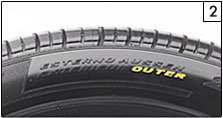DocL said:
There's a reason why tires need to be mounted in a specific direction, just look it up. Here's a great link that I'm more than happy to share with you.
http://auto.howstuffworks.com/tire.htm
If you understand the reasoning, why do you keep bringing up and asking the same questions. Why don't you just call Bridgestone and ask them the same questions that have already been answered here, some of which are common sense.
Thanks for the link...however it said nothing in there explaining how asymmetric tires are built. What makes them different from a standard directional tire.
Yeah, directional is common sense...but If the properties of asymmetrical tires are common sense to you...why don't you explain so the rest of us know??
I appreciate the opinions and explanations that a few of you gave.....
After doing some of my own research...here is what I found out:
Yokohama and Pirelli are the major players that are manufacturing Asymmetric tread design tires. The design of this tire is predominantly for the purpose of a more solid shoulder for better turn in response.
Yokohama calls referres to this attribute as Low Void Shoulder. Yokohama states that this feature enhances vehicle stability. Decreased groove area in the shoulder area and increases rubber-to road-contact. The result is noticably sharper cornering with less tread squirm.
Pirelli states: The outer element, with robust blocks, ensures excellent dry grip whilst the inner circumferential element has wide grooves for rapid water dispersal. The shoulder sipes moderate the rigidity of the longitudinal tread blocks to improve quietness and comfort but, comfort in particular, is resultant of the multi-pitch pattern and compliant tread compound.
These tire patterns show sidewall branding
indicating "side facing outward." The odd,
often metioned thing about this tread design
is that the inner part of the tread design will
often appear to be runing the "wrong way"
on one side of the vehicle, rest assured
they are not.






